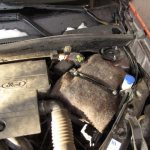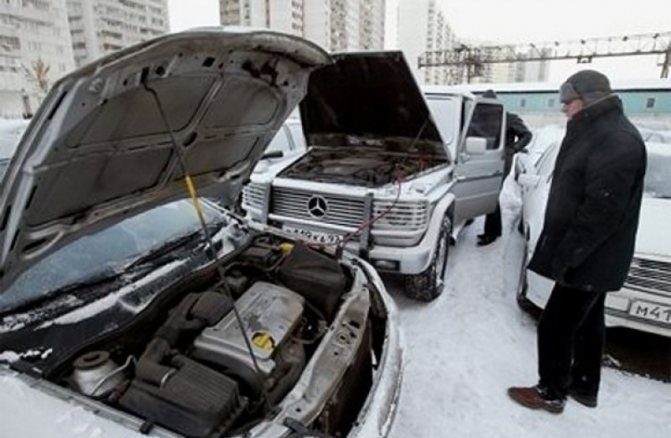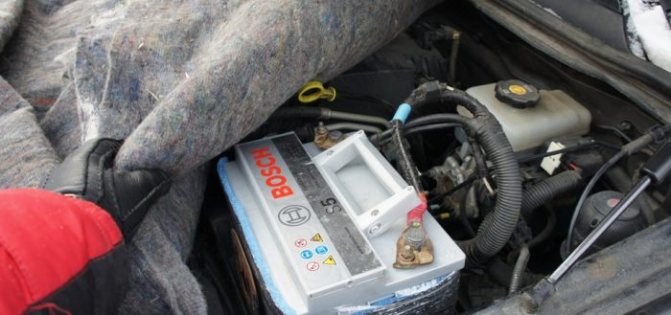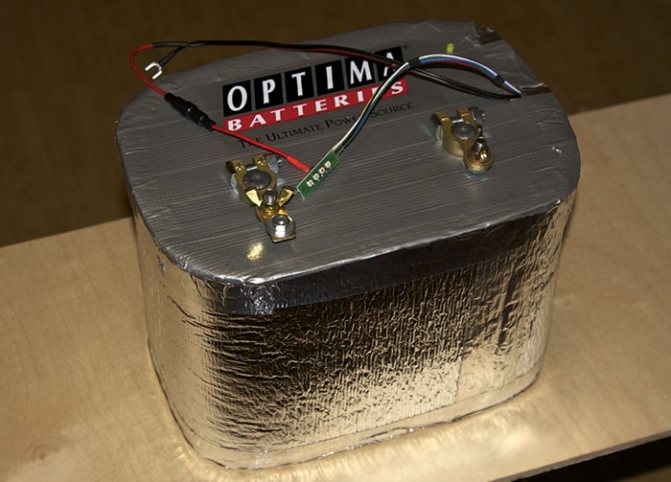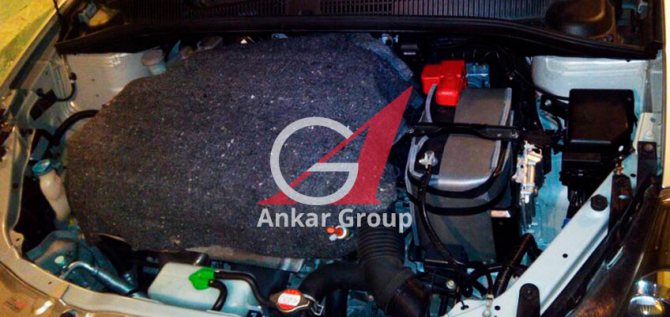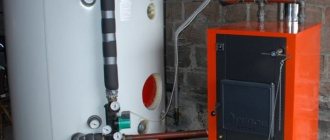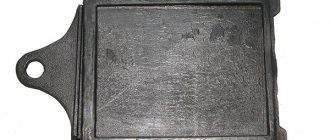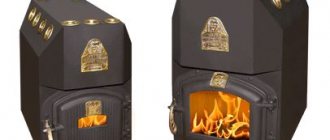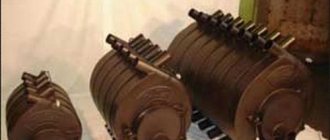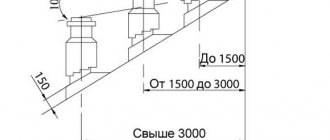Battery storage
Winter divides motorists into two groups. The first includes those who continue to operate their car even after the onset of cold weather. And the second group consists of people whose cars spend the winter “in hibernation” in garages or even just on the street. If you belong to car owners of the second group and are going to close your iron friend in the garage until spring, then it is recommended to disconnect one of the battery terminals. Then it is discharged very insignificantly and you do not need to recharge it. But with the onset of severe frosts, in order for the battery to stand all winter without problems, it is better to completely remove it and bring it into a warmer room, unless, of course, your car does not winter in a heated garage. How to save your battery in winter:
Storage conditions are different for dry-charged or electrolyte-filled batteries. It's somehow easier with a dry-charged battery. The most important thing here is that it is stored in a dry and well-ventilated area. Direct sunlight is harmful to him. If they hit the case, they can damage the plastic. A dry-charged battery should be left for storage, making sure of its tightness and tightness of the plugs on the cans
Make sure the battery is not damaged. Like a dry-charged battery, a battery filled with electrolyte must be stored upright
It is impossible to drain the electrolyte during storage - you risk being left without a battery at all. After removing the battery filled with electrolyte, clean its body from dirt, especially from traces of electrolyte. When the level of electrolyte in the cans drops, you need to top it up to the set level. Distilled water should be added. Do not use acid or water from the mains for this, it is a death sentence for the battery. After refilling, the battery is fully charged. The battery should be recharged periodically during storage so that it does not completely discharge.

Craftsmen are trying to protect the battery from frost in various ways.
There are situations when a motorist does not have the opportunity to check the safety of the battery and recharge it until the very onset of heat. In this case, boric acid, or rather its 5% solution, will help. After completing all the procedures, namely topping up the electrolyte to the set level and charging the battery to the maximum, you need to drain the electrolyte solution within 15-20 minutes. The next step is to thoroughly rinse the battery with distilled water. You will need to wash it twice, holding the distilled water in the battery for about 20 minutes. And now you can pour a solution of boric acid into a clean battery. All that remains is to wipe the battery and put it away for storage. It is worth remembering that with this method of storage, the temperature in the room should not fall below 0 ° C so that the solution does not freeze. The use of this method will completely exclude the possibility of self-discharge of the battery during the entire storage period. When you need to use the battery after winter, you will need to carry out a few simple procedures to "wake up" her. Within 15-20 minutes, the boric acid solution is drained. The electrolyte is immediately poured. After 40 minutes, the density of the electrolyte should be checked. If it has not changed, you can install the battery in the car. When the density decreases, it will be necessary to bring it to the required level.
General features and principle of operation
The battery in the car is an important element of an electronic device
, which together with the generator provides the current. In the car, the battery is designed for the following functions: supplies power to the starter to start the motor; provides power consumption for electronic systems when the engine is off; supplies the system when the motor is on, together with the generator.
What are the batteries
There are two types of rechargeable batteries - with liquid electrolyte and electrolyte absorbed into a special material (not liquid). A more common type of battery with liquid electrolyte. The battery is charged by gassing, and the gases are vented by means of a ventilation system.
How to connect the battery correctly
Connecting the battery to the vehicle electrical system
is made through two wires of lead material. The positive (plus) wire will always be thicker than the negative wire. Some car batteries have an indicator that shows the battery charge.
The density of the electrolyte can be recognized by the color of the indicator: green means that the battery is charged; black - the battery is not charged enough; yellow indicates a low electrolyte reading. In any vehicle, the battery must be well installed with the appropriate mount to avoid battery damage and electrolyte leakage. There are top and bottom individual mountings.
If the battery is located in the trunk of the car or in the middle of it, then an emergency battery disconnector must be additionally located.
The battery will last about three or four years, depending on operation and maintenance. When the required load is not available on the battery, self-discharge occurs, especially during the cold season.
How the battery works
quite simple is charging and discharging the battery. Electric energy is converted into chemical energy when charged, and vice versa when the battery is discharged. When the engine is running, the battery is charged by the alternator. The battery can be charged with a special charger. The passenger car has a power supply voltage of 12 volts. The operation of the storage battery directly depends on the cold as the temperature decreases, the charging capacity decreases, the density of the electrolyte becomes lower with slowed down chemical processes.
The nominal capacity is calculated as the energy that a fully charged battery gives up when discharged in twenty hours of operation. Under the influence of severe frost, the oil thickens and the liquid in the cooling system is supercooled, which means that the battery needs a larger capacity to start the engine.
Battery cold cranking current: what is it
Cold cranking current
Indicates whether the battery will be able to start the engine in cold subzero weather. If the battery current for ten seconds with a minimum voltage of 7.5 Volts will be able to deliver at a temperature of - 18 0 C. When the cranking current is higher, it will be much easier to start the engine in winter.
How to save the battery in winter if the car is stationary
Many motorists rarely drive out in winter or try not to drive at all in winter. The reasons for this are different for everyone, not all drivers care about preserving the battery. Leaving the car with the terminals connected for a long period, you get a completely discharged battery. The surest way to maintain the maximum charge is to remove the battery for the winter and place it in a warm room, before that it is advisable to check the electrolyte level. In the vehicle on-board system, when the power source is removed, all electronic settings will be reset.
How to store a car battery in winter
Store the battery in the same position as it is in the car, never on its side or upright.The battery should not stand in direct sunlight, the best place for storage will be a dark room with an optimal temperature of -5 0 С (a cellar or basement is perfect).
If the car itself is already in an insulated garage, then you need to disconnect one terminal from the power source. In a heated room, the battery does not need to be charged without the need at all. Experienced car enthusiasts recommend removing the negative terminal, due to this it is possible to effectively reduce the process of losing the power supply charge.
Recharge a dead battery
, which is sent for storage in a non-car, you can use a specialized charger with a charging frequency of once a month. Only distilled water can be poured into the battery. If the battery is discharging very quickly and does not hold a charge, it means that it is better to replace it with a new one.
How to insulate a battery for the winter with your own hands
Air temperature conditions for normal operation of the battery range from +25 0 C to -15 0 C. When the electrolyte temperature drops below -15 0 C, respectively, the capacity of the battery will drop by one percent with each temperature drop. In severe frosts, many car owners prefer to keep the battery warm so that the engine can be started without problems in the morning.
There is also an alternative - battery insulation. You can buy a special cover for insulation at an automotive accessories store or do it yourself. It is better to insulate the battery, without waiting for severe frosts to t 0 -18 0 C. If you use the machine every day, then a simple wrapping is suitable, which will keep the heat from four to eight hours. The only drawback of this method is that the battery will not receive heat from the engine. In the case when the car stands for a long time, the battery will quickly freeze and discharge.
A more reliable way is to insulate the battery together with the motor unit. You need to start insulating the engine compartment from the radiator. You can take basic cardboard and place it in front of the radiator. The insulation must be positioned in such a way that it covers the upper and lower branch pipes, after which the side of the battery, which is turned towards the radiator, is protected. The side of the battery that is adjacent to the motor does not need to be insulated (the heat from the motor will heat the battery). Last of all, the hood is insulated, heat-insulating material is attached to the inside.
Outcome
Timely charging, proper insulation and operation of a car battery not only prolongs its service life, but also ensures a stable start of the car engine even in severe frosts.
The winter period of time makes its own changes in seemingly ordinary things. Now many of us are trying cars for easy starting of the engine in the morning. It's just a boom in the so-called - "thermal cases", and many of the motorists make them with their own hands! Is such a "fur coat" justified for the battery, is it worth putting it on, and is it worth doing it yourself. Read to the end, you will get a lot of useful information ...
I'll start with the definition.
Thermocase
- it is a durable, often even hermetically sealed soft "thermos" made of a special fabric or material that does not allow cold or heat to pass through. Must keep the battery temperature within the operating range at all times, which is conducive to battery life. If both the cover itself and the version c, when low-current heating elements are installed under this fur coat downwards.
It seems that this is happiness - you bought or made such a "thermal case" with your own hands and you don't care about winter! But in the structure of this case, a bunch of questions immediately appear, which, if you figure it out, will, on the contrary, contribute to the failure of the battery. And if you think about such a device, you need to choose or do it right.
Accumulator charging
(Charging the maintenance-free battery)
Replacing the battery in the DVR.Step by step, do it yourself
* more fully ways to charge car batteries are described on the page
1. The battery is charged with a current of 3.5 - 4 A. Continue to charge the battery with this current until an increase in the density of the electrolyte is observed. When four hours have passed since the last increase in density, you can stop charging the battery. 2. Alternatively, the 1.5 A battery can be charged safely overnight. 3. Charging too fast, allowing the battery to fully recharge within 1 to 2 hours, is not recommended as this can cause serious damage to the battery plates due to overheating. 4. When charging the battery, make sure that the electrolyte temperature never exceeds 37.8 ° C.
Maintenance-free battery:
1. A full charge of this type of battery takes significantly longer (up to three days with a significant discharge). 2. A charger with constant voltage is required for charging. After connecting, the device must be set to a voltage of 13.9 - 14.9 Volts at a current below 25 A. With this method of charging, the battery will be usable after three hours, giving out a voltage of 12.5 Volts. Such a charge period is realistic if the battery is only partially discharged, a full charge takes much longer. 3. If the battery is being charged from a completely discharged state (voltage below 12.2 Volts), entrust the charging to a workshop, as this process requires constant supervision by a specialist.
Official recommendation for charging Varta batteries:
It is recommended to recharge the battery before installing the battery on the vehicle! It is recommended to charge at a constant current equal to 1/10 of the battery capacity. The charge is considered complete 2 hours after the battery voltage reaches 16.0 V.
Battery insulation methods
DIY car battery terminal repair
You can often find advice on the comprehensive insulation of the entire "podkapotka", but this is not economically justified. The pluses of such an event include:
- Insulated radiator, the engine will "thank" you during operation, for it it has a positive effect on work.
- In addition to the engine, the fuel system, the starter are in a heated state, all this cools down rather slowly and for a long time, which subsequently affects the ease of starting.
- The battery, due to the single insulation with the motor, will freeze less, which means that the likelihood of starting the car in the morning increases.
Comprehensive car insulation
The car must be insulated in the following sequence:
First of all, pay attention to the radiator, initially you need to insulate it. If there is no special material, you can make insulation from ordinary cardboard.
The main thing is to install it correctly, that is, you need to close the pipes from hypothermia. Then we insulate the engine, for today there are a huge variety of all kinds of "blankets" on sale, even for different motors and models. Or you can simply buy the required piece of insulation yourself and cut the required piece. With the help of it, either the motor is covered or is attached to the hood. After that, a heater for the battery is made from the same material, it is better to leave one side from the engine side removable so that you can warm up the battery while the power plant is running.
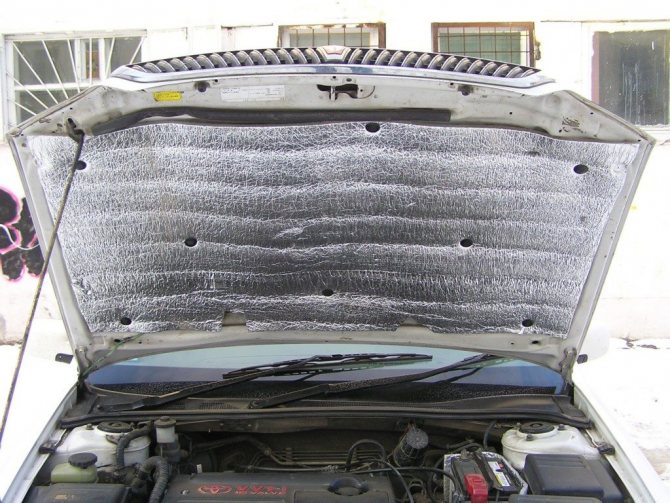

Should the battery be insulated for the winter?
Puzzled about how to insulate the battery for the winter, you can subsequently make it much easier to start the power plant of an off-road car on a frosty winter morning. The easiest way out of the situation is to remove the battery at night and place it in a warm room for this time.However, if such a procedure was not performed, then in the morning the starter may not have enough energy available from the battery to effectively start the power unit.
To eliminate this problem, it will be enough to remove the battery and immerse it in a container filled with hot water. As a result, within an hour, an almost completely discharged element will have the ability to release a sufficient amount of energy to rotate the crankshaft with a starter with sufficient intensity. From the above options, we can conclude that the need to insulate the battery for the winter can be ignored, but as a result, there will be much more problems and unnecessary actions.
Rating of the best heaters
Do-it-yourself battery indicator controller
First of all, we will discuss heaters for the engine, since they are the more popular products than their counterparts for the radiator and battery. According to the reviews of motorists on the Internet, the most common trademarks under which these products are produced are TORSO, STP HEATSHIELD, SKYWAY, Avto-MAT and Avtoteplo. They will be discussed further.
Car blanket TORSO
A distinctive feature of the TORSO car blanket is its low price. For example, a product measuring 130 by 80 cm as of the beginning of 2020 is about 500 rubles. However, a significant disadvantage of this product is the lack of official certification. Car blankets are available in various sizes, so they can be used on both small cars and crossovers and SUVs. The warranty period for this car blanket is 3 years. The weight of a product measuring 130 by 80 cm is 1 kg. The article number is 1228161.
Insulation STP Heat Shield
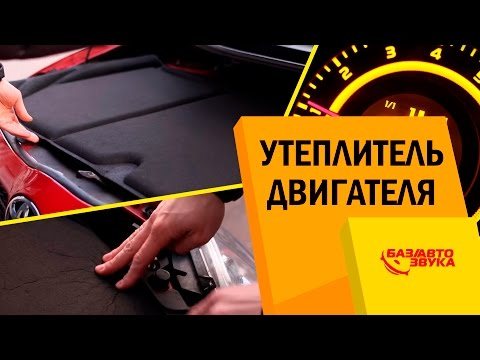

StP HeatShield engine insulation
The STP Heat Shield car blanket also comes in different sizes for both passenger cars and SUVs. For example, there are sizes 600 by 1350 mm, 800 by 1350 mm and others. A distinctive feature of these products is the presence of not only heat, but also sound insulation. Also in the summer, the protection can be used between the engine and the passenger compartment, which reduces the noise load in the passenger compartment. The blanket consists of the following materials:
- non-woven fabric resistant to oil, fuel and other process fluids;
- noise and heat absorbing layer;
- an adhesive layer that is resistant to high temperature extremes, and serves as a mechanical basis for insulation.
The product is attached using the included 8 clips. With their help, you can fix the blanket in the summer. In winter, however, it can be laid directly on the engine housing. The cost of both these models is approximately the same and is about 1000 rubles.
Skyway car blanket
11 models with different dimensions are produced under this brand. The peculiarity of the products lies in the excellent ratio of price and quality. According to many car owners, the blanket lasts about 2.3 years without loss of performance
The conditional disadvantages include the easy possibility of damage to the surface of the product, which is why it is necessary to install the insulation carefully so as not to damage it. Despite the differences in size, the price of heaters is approximately the same and amounts to 700
800 rubles as of early 2020.
"Machine"
Under this brand, two types of car blankets for the engine are produced - A-1 and A-2. Both models are similar to the products described above. They are non-flammable, non-conductive, resistant to acids, fuels, oils and various process fluids used in a car. The difference between them is the maximum temperature. In particular, model А-1 can withstand maximum temperatures up to + 1000 ° С, and А-2 - + 1200 ° С. There is also a model A-3, designed for battery insulation.Its properties are similar to the first two. It differs only in size and shape. The price of an auto blanket for the engine as of the beginning of 2020 is about 1000 rubles apiece.
"Avtoteplo"
This is the most famous and popular blanket among domestic motorists. Its distinctive feature is the fact that the manufacturer positions it as a heater for the engine compartment, and not as a heater for the hood. The product can be used at temperatures up to -60 ° С, while it prevents icing of the engine starting mechanisms. Insulation "Avtoteplo" is a fire-safe product, and is able to withstand temperatures up to + 1200 ° С. The car blanket is not afraid of moisture, oil, fuel, acids and alkalis. It has a significant service life, can be used with both cars and trucks. According to the reviews of motorists, it is best to buy an appropriate car blanket, produced by a company from Chelyabinsk with the same name "Avtoteplo". Also, when buying, check the availability of all permits and a passport for both the purchase itself and the product. The price at the beginning of 2020 is about 1,500, 2,000 rubles, depending on the size. Blanket article number 14 - AVT0TEPL014.
Simple do-it-yourself heat accumulator
It is quite simple to make a heat accumulator for a solid fuel boiler with your own hands if you follow the instructions. The creation of a TA should start with the calculation of its volume. You can use the following technique:
We set the initial data


Maximum water temperature: Tmax = 90 degrees.
Minimum water temperature: Tmin = 50 degrees.
Operating time without boiler participation: t = 8 hours.
Also, for the calculation, you will need the required thermal performance of the heating system (CO).
The average should be taken, and not the one that corresponds to the most extreme frosts. Otherwise, the TA will turn out to be unjustifiably large and expensive, and to charge it you will need a very powerful heat generator.
The most correct way to determine the heat transfer power is to calculate the heat loss at home. But for example, we will use a simplified technique, according to which for heating an area of 10 sq. m in the coldest period of winter, 1 kW of heat is required. Then the maximum CO power for a house with an area of 200 sq. m will be 20 kW, and the average indicator will be taken equal to W = 10 kW.
Volume calculation
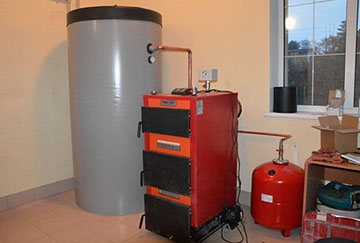

Based on the data obtained, we determine the amount of energy that the TA should store:
Q = W x t x 3600 (converting hours into seconds) = 10000 x 8 x 3600 = 288 MJ.
The heat capacity of water is (take the value for a temperature of 70 degrees): c = 4190 J / kg * degree.
Then we need water:
m = Q / c (Tmax - Tmin) = 288,000,000 / 4190 (90 - 50) = 1718 kg.
Taking the height of the tank equal to 2 m, we determine the base area: S = 1.718 / 2 = 0.859 sq. m. This area will have a circle with a diameter of 1040 mm.
For further calculations, the surface area of the container without a bottom is required. It will be equal to S = 0.859 + 3.14x1.04x2 = 7.39 sq. m.
Thermal insulation thickness calculation
The thickness of the insulation should be selected taking into account the heat output required for heating the boiler room. The thermal conductivity of modern heat-insulating materials is L = 0.040 W / m * degree. Therefore, if we take a heat insulator with a thickness of d = 100 mm (0.1 m), then from a fully charged TA (water temperature - 90 degrees) it will penetrate into the boiler room
q = S * (Tmax - 20) * L / d = 7.39 * (90 - 20) * 0.040 / 0.1 = 206.9 W of heat (20 is the air temperature in the room).
If this indicator does not suit you, the thickness of the insulation must be reduced.
Unusual ways to insulate the battery
Interesting insulation methods include:
- "Chill";
- onboard network;
- nichrome thread;
- factory insulation.
Heating by "chilled water"
Many people know how the engine is heated - by circulating antifreeze through special channels. Here we will consider a similar system when a branch is made from the stove or from another place. Several or one tube is made from it, encircling the battery. There is a simultaneous heating of the antifreeze and its circulation around the battery.
Such a system is very rare; additional work is required to lay the pipeline. Moreover, removing the battery will be laborious. Moreover, in this way, it is quite likely even to overheat the battery. In this case, the electrolyte will boil, and the subsequent actions are simply not realistic to predict, given its explosive properties. You can, of course, protect yourself, carry out additional insulation, but in our experienced opinion, this work is not worth the "candle".
Heating by means of the on-board network
In this way, you need to make parallel circuits. Keep in mind that in each circuit, the resistor is in series. The resistance will depend on the expected temperature and current. Thus, energy costs will increase and thereby increase heating.
There is also a significant drawback in this method, namely, during the night of such work, the battery will simply "run out". Therefore, there is no sense in such a "design", unless, of course, the machine is constantly running. Or you can solder a controller that will disconnect the network when the voltage in the battery drops below 12 V. In this case, you will have enough capacity to start.
There is also another option, namely, "powering" does not come from the main battery. That is, power is taken from the second battery. For this, a regular AGM from an uninterruptible power supply is suitable. In addition, if you have skills in electrics, you can get so confused that you can put the second battery on charge from the generator.
Heating with nichrome thread
The principle is generally similar to the previous method, but here a nichrome thread is used as a heater. Instead of resistance, it is wedged into the circuit. It can even be used in some kind of wrapper. By the way, such threads are often used to heat the steering wheel, seats, so finding them is not a problem.
Dimensions, cross-section are selected depending on the power of the heater. The increase in power occurs by increasing the number of threads around the battery.
Factory insulation
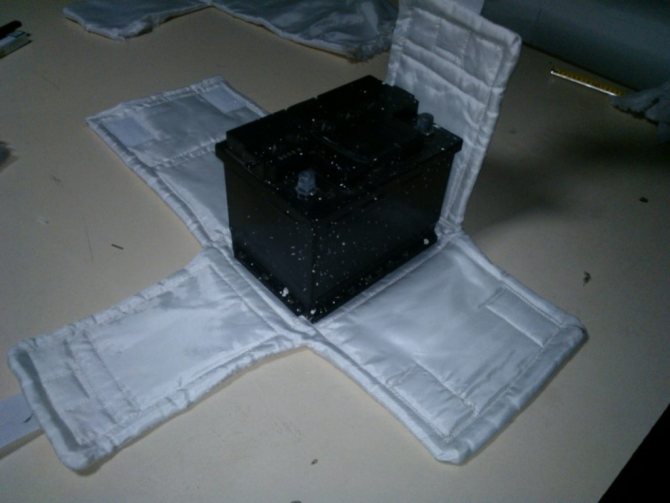

Often they differ only in better quality performance, but, in essence, they have similar schemes with a combined mode. That is, there is thermal insulation, threads or chains inside. The wires are brought out from the heater, which can be "light" in the car or connected to a backup battery. As already mentioned, you can use no chrome threads, either in a combined way or separately.


Car battery insulation options?
Comprehensive insulation of the engine compartment
Many recommend performing a comprehensive insulation of the entire engine compartment. This provides improvement in several ways. What are the advantages here?
- You insulate the engine and radiator, which has a positive effect on their work in the winter;
- In addition to the engine, the injector, oil, air and oil filters are warmed up. All this cools down more slowly and the engine will be easier to start;
- The battery is located next to a warm engine and, in turn, is insulated. Therefore, he will not freeze deeply overnight.
Insulation of the engine compartment
The best way to start is to insulate the radiator. If there is no suitable material at hand, then this can be done using ordinary cardboard. Here it is important to install it correctly so that it hides the upper and lower pipes from cooling. After that, the motor is insulated. This is done in combination. On sale you can find insulation blankets for different car models. You can also buy insulating material and cut a piece out of it to size. They either cover the engine or fix it on the hood lid.
Then, the battery is insulated from the same material. A detachable side can be made on the engine side to open it for warming up while the engine is running.
DIY battery insulation options
"Fur coat" for a battery made of various materials
Here the question immediately arises: how to insulate the battery? Which material should you choose? Below are the main materials that battery owners use to insulate them.
Battery insulation materials
Heating with coolant
Some arrange heating of the battery with antifreeze, which circulates in the engine cooling system. A similar scheme is put in the stove of the car interior. A branch is made from the stove (or from another place in the cooling system). A tube is led from it, which encircles the battery. Effective insulation is obtained. The engine heats up and the hot antifreeze heats up the battery.
But such a scheme, of course, is rare. After all, here you need to make extra pipelines that can flow. Removing the battery for service will be problematic. In addition, the battery can easily overheat. Then the electrolyte will boil, which is not at all good for him. Overheating can be prevented by installing additional heat-insulating material between the tubes and the walls of the battery. But all the same, the solution, in our opinion, is not very convenient.
Heating the battery from the on-board network
This is done by connecting several parallel resistance strings. In each chain, resistors must be wired in series. The nominal resistance depends on the amperage and the required heating temperature. With an increase in resistance, energy consumption will increase and heating will increase.
How to keep the battery warm in winter if the car is standing for a long time
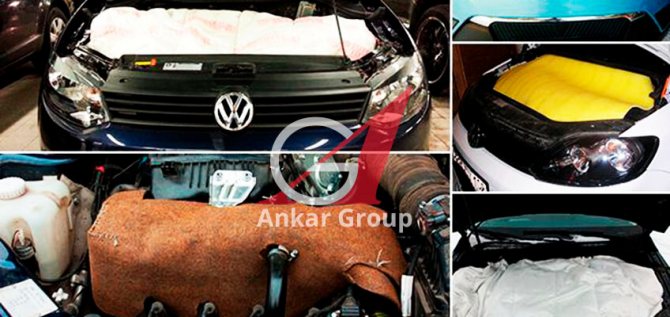

The methods described above work well if the car is not idle for a long time. The fact is that this kind of insulation has disadvantages:
- Keeping warm for a long time will not work. If you leave the car overnight, even with insulation, the battery will still cool down. Keeps warm for an average of 4 to 8 hours.
- Due to this kind of insulation, the heat from the car engine does not come. As a result, the battery will still freeze and discharge.
We repeat once again, the battery insulation by various wrapping methods works only if the car is used regularly and without interruption.
What then to do, and how to insulate the battery for the winter with your own hands, if the car is idle at night and trips are not frequent?
Thermo blanket. Thermal insulation of the battery with the engine


Many drivers speak positively about this method, because it is the most practical and efficient. It also keeps the engine warm.
You can sew a special cover yourself, or you can purchase it at a car dealership. It covers the engine and battery, which is why the battery, being next to a warm engine, does not have time to cool down.
You should also cover the radiator with cardboard so that the oncoming cold air does not enter, this will give additional protection. And the battery itself is insulated
It is very important here that you do not need to insulate the side facing the engine. Warm air must flow from the motor and warm the battery


In a car dealership you can find on sale a thermo case for a heated battery. The heating elements keep the battery at the optimum temperature.
The principle of its operation is as follows:
- The battery is placed in this case.
- When the engine starts, the plates begin to heat the battery up to 25 degrees.
- When stopped, the heating stops, and the thermal case itself retains heat, reducing heat loss.
Such thermal protection for the battery against frost is very effective, because In this case, the battery cools down longer than usual.
On the Internet, you can find many ways to insulate a battery for the winter with your own hands. Each has its own pros and cons. Remember that these methods are only suitable if the car will not be standing in the cold for a long time.Avoid frequent and short trips in frosty weather, drive a sufficient distance so that the battery has time to warm up and fully charge, this is the only way to ensure an easy and stable engine start even in the most severe frost. Otherwise, it is better to use special heaters or auto start of the car engine.
How to insulate a battery in a car for the winter


The best temperature for car battery operation ranges from from -15 to +25 degrees... As noted above, if the air temperature drops below -15 degrees, the battery loses capacity. For this reason, many car owners prefer to store it at home, but this is not very convenient, because it must be permanently disconnected and connected.
There is another way - insulate the battery for the winter... This old-fashioned way in practice shows that with daily use of the machine and night idle time of 8 hours, this method can significantly minimize the loss of battery capacity. Consider how to insulate the battery for the winter with your own hands.
How to insulate a battery for the winter with foam
Polyfoam is an inexpensive material, you can always find it in the store or at home. It is enough to choose the required size and thickness. It is necessary to make a box from polystyrene, while gluing the joints and walls tightly.
Then the battery is placed in this box and closed with a foam cover with holes for the wires. It is very important to do so that there are no gaps that would allow air to enter.
How to insulate a battery for the winter with foil insulation
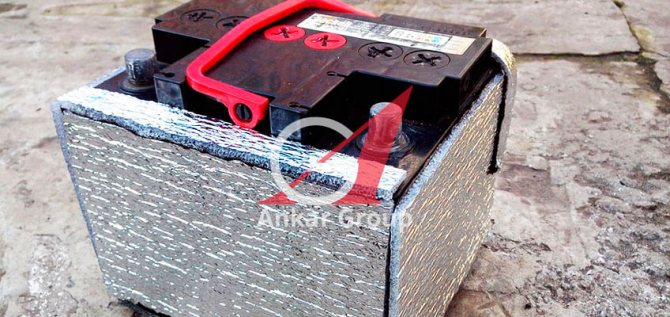

Folgoizol is quite flexible and comfortable material. Provides very good thermal insulation. We recommend using three coats for better performance.
- Measurements are made, foil insulation is cut out onto the walls of the required dimensions.
- Then the foam is cut out with a thickness of about 2 cm.This will be the second (middle) layer.
- And the 3rd layer (outer) is foil-insol again.
It is better to glue polyfoam with glue, and foil-insol is held together with tape. The lid is made according to the same principle. The thermal chamber for the battery is ready. Its downside is that the heat from the motor in this case will not flow, and when the battery is charged, it emits too little heat.
How to insulate a battery for the winter with felt
You can also insulate the battery with felt, sewing a kind of case from it. Multiple layers of felt can be used. This method has worked well in practice, especially if you use the car every day. Such a cover will keep the battery warm for 4 to 8 hours. A significant disadvantage is that the heat from the motor will not come well.
Car battery insulation must be taken seriously and with full responsibility. This must be done before frost sets in. And besides, it is very important to know what material to use for this, so as not to harm the car with your actions. Do not use materials that are easily flammable, do not use fur, down pillows, cardboard.
Advantages and disadvantages of auto blanket
The experience of using insulation for a car goes back to the old days, when cars were carbureted, and 76 gasoline was widely used. Naturally, such cars warmed up very slowly in frost, and cooled down, accordingly, quickly. However, these times are long gone, cars became injection cars, and gasoline became more high-octane. Accordingly, less time is spent on heating them.
Currently, there are three types of heaters - engine, radiator and battery. Let's start our review with the most common one - the "blanket" for the engine. The advantages of using it are as follows:
- The engine warms up faster at negative temperatures. This fact is provided by the effect of a heat shield, which prevents heat from the engine from rising up and spreading through the engine compartment and heating the hood.
- After stopping the power unit, the latter remains warm for a long time. This becomes relevant in case of short stops, then it is easier and easier to start the car.
- Thanks to the use of insulation for the car hood, the warm-up time is reduced. This follows from the first item on this list.
- If the car is equipped with auto-heating by temperature, the number of engine starts per night is reduced by 1.5. 2 times (for example, from 5 to 3).
- No ice build-up on the bonnet. This becomes possible due to the fact that the heat from the motor does not heat it up, and, accordingly, moisture from the outside does not crystallize.
- The insulation slightly reduces the noise load both inside the car and outside.
Before describing the shortcomings, it is necessary to clarify several nuances on which they may depend. In particular, the insulation works differently with turbocharged and atmospheric engines, at different temperatures (for example, -30 ° and -5 ° C), under different driving conditions (in the urban cycle and on the highway), when air is taken from the radiator grill or from the engine compartment. The combination of these and other objective conditions gives a different result of using car blankets for engines, batteries and radiators. That is why often such blankets can lead to the following troubles:
- overheating of the engine, which is bad in itself, and can threaten the failure of its individual parts;
- at a relatively high temperature (about -5 ° C ... -3 ° C), ignition coils and / or insulation of high-voltage wires may suffer;
- if warm air enters the system, there is a risk of late ignition, which may increase fuel consumption;
- as a rule, when using a heater for a car, engine power drops, of course, fuel economy is out of the question;
- when buying a low-quality blanket for the engine, it may catch fire !;
- most modern heaters for a car battery, its engine or radiator have a short service life - about one to two years.


Should I use a car blanket
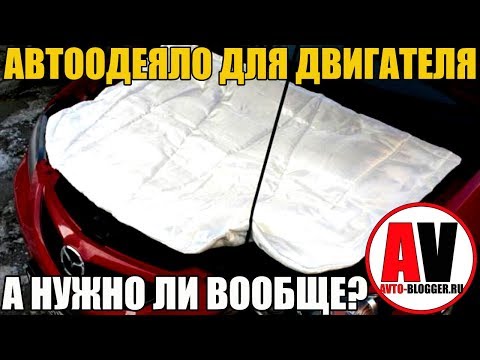

Thus, the decision on whether to buy engine insulation or not to do it depends on many factors. In particular, if you live in latitudes where in winter the temperature drops to -25 ° C and below, and at the same time the engine on your car warms up for a long time, then yes, it makes sense to think about buying. But if the temperature in winter in your area rarely drops below -10 ° C, and at the same time you own a modern foreign car with a good heating system, then you hardly need to worry about a car blanket.
Principle of operation
The principle of operation of the heat accumulator is based on the high heat capacity of water. It can be described as follows:
- The boiler pipeline is connected to the upper part of the tank, into which hot water enters - the most heated coolant
- At the bottom there is a circulating pump that selects cold water and runs it back into the boiler through the heating system.
- The previously cooled liquid very quickly is replaced by a newly heated one
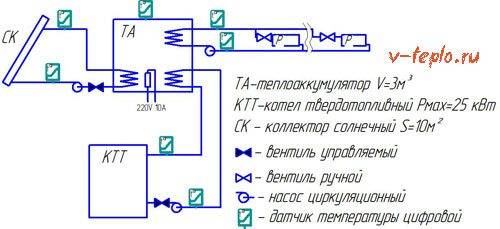

When the boiler stops working, the water in the pipelines of the heating system begins to gradually cool down. Circulating, it enters the tank, in which it begins to squeeze the hot coolant into the pipes. Thus, the heating of the premises will continue for a certain period of time.
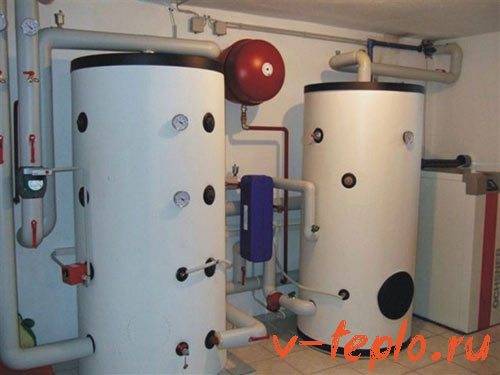

Functions performed by the heat accumulator
Modern heat storage devices are complex devices that perform more than one useful function:
- Are able to provide the house with hot water supply
- Stabilize indoor temperature conditions
- Allows you to increase the efficiency of heating systems to the maximum possible, reducing cash costs for fuel
- Able to combine more than one heat source into a common circuit and vice versa
- Accumulate excess energy generated by the boiler
Despite all the positive functions that the heat accumulator performs in the heating system, it has two significant drawbacks:
- The water resource directly depends on the capacity of the installed tank, however, it remains limited and has a quick property to end. An additional heating system from outside will not be superfluous
- From the first drawback, the second smoothly appears: more resource-intensive installations require a large free area for their placement, for example, a separate room in the form of a boiler room
In addition, we advise you to read our DIY solar collector assembly guide.
How to use the battery in winter
Subzero temperatures greatly affect battery performance. In extreme cold, the electrolyte thickens, which complicates the chemical processes of the battery itself. This leads to a decrease in current generation and affects the start of the engine in cold weather. For low temperatures, there are electric accumulators with a large capacity, for example, 10 ampere-hours.
There are special heaters for the battery
In off-road conditions, the battery is subject to constant shaking. Electrolyte begins to escape from the plates, increasing the chance of a short circuit. For such needs, there are special batteries that have plates of the same polarity rolled into a separator.
Frequent use of the starter drains the battery, creating the risk of running out of power at the most inopportune moment. The problem can be partially solved by replacing the battery with an analogue, which has a self-charging function and is equipped with a plastic separator envelope.
Calcium batteries withstand temperature changes better
The above-described calcium batteries perfectly withstand both low and high temperatures, can be stored for many months without use, and are installed as easily as conventional batteries, without needing to recharge. However, most drivers will continue to use the alkaline batteries they are accustomed to. There are two rules for their operation:
- Monitor the battery charge level;
- Check the electrolyte level - it should cover all cells. Always have distilled water with you, because electrolyte tends to evaporate both in summer and winter.
Training
- Stock up on containers for draining the used electrolyte and diluting a new one;
- Test the plastic for electrolyte resistance before use.
To raise the density of the electrolyte you need:
- container with measured marks;
- hydrometer;
- soldering iron;
- electrolyte;
- enema pear;
- storage water;
- drill;
- distilled water.
We measure the density in each jar. If it is 1.25–1.28, and the spread is not more than 0.01, then the battery is normal and can be used. If the indicators fluctuate at the level of 1.18-1.20, then you need to add an electrolyte with a density of 1.27.
- Pump out the largest possible volume of old electrolyte from the can with an enema and measure it;
- Pour in a new solution at the rate of half of the pumped out;
- Gently shake the battery to mix liquids;
- Measure the density - if the value is insufficient, you need to add more electrolyte;
- Fill the remainder with distilled water.
Battery behavior during temperature changes
As you know, the battery carries very strong loads, in addition, during temperature extremes, they are even more intensified. Depending on the weather. For example, in the summer season, the temperature of the "engine compartment" may well reach 100 degrees, and in the winter it can drop below zero. During the operation of the motor, the battery, due to its close proximity to the heat source, in the particular case, this is the engine, heats up quite strongly, this is especially noticeable in winter.
During a stop, parking, the battery is compared in temperature with the environment, and this threatens that at some point you simply will not be able to start the car.It is known that even a small drop in temperature, say by 1 degree, "steals" from your battery about 1 mAh. This leads to the fact that you have much less capacity and, accordingly, attempts to start the engine. And given the fact that after a long stay (at night) in frost, the oil thickens, more energy is required for scrolling, and where does it come from if the capacity falls.
A more global problem lies in wait for the owners of diesel vehicles. The constant lack of energy in city driving is also added. As a result, getting up in the morning, you find a completely discharged battery. Keep in mind that if the frost is strong, with a discharged battery, the electrolyte may simply freeze. To try to avoid such embarrassment, it is better to keep the battery warm or take all measures to insulate the car battery with your own hands.
How to do it yourself
If you wondered about the thermocase with your own hands, then it's not so difficult to do that. Many people use penofol as the main insulating element. It is polyethylene foam with a reflective surface.
One layer will not be enough, so first it is worth wrapping the battery with the first layer with a shiny surface inward, then the second outer layer, on the contrary, with a shiny surface outward. Thus, we simulate the effect of a thermos, the temperature will slowly penetrate inward and also go out. Above and below the battery, the same is made - the bottom and the cover, special holes are cut out for the terminals. You can fasten ponofol with special construction tape.
Check out this helpful video.
At this I will finish, my article - a review. Do the thermal case wisely, otherwise, on the contrary, there will only be troubles from it. Read our AUTOBLOG.
During the winter operation of an SUV, many car owners are often puzzled about how to insulate the battery for the winter. The problem that many jeep owners can solve with their own hands is that the density of the electrolyte of the battery is directly dependent on the external temperature regime. With a decrease in the battery temperature, the density of the electrolyte decreases, which leads to a reduction in the capacity of the energy cell.
What is the bottom line
We add that additional insulation in severe frosts does not allow the hood to freeze with the engine running and after it stops. This means that freezing rain or snow that falls on the hood will quickly melt and evaporate. In other words, a thick layer of ice does not form on the hood, which has a positive effect on the state of the paintwork (paintwork) on the hood surface, taking into account the absence of mechanical effects of ice and cracking of the coating during temperature changes.
- It should also be noted that it is possible to insulate the engine compartment of a car with the help of fireproof materials in a comprehensive manner. To do this, you need to close all the slots through which outside air enters under the hood. Work of this kind will require the owner to dismantle individual elements that are installed on the engine itself, as well as body parts (front fenders, head optics, front bumper, etc.).
- When installing the insulation, individual parts should be securely fixed, since tearing off the thermal insulation in motion can lead to damage to the engine or attachments. Adding thermal insulation to the cooling fan, drive belts, rollers or pulleys increases the risk of serious failure.
- When preparing the car for winter, remember that the engine runs on flammable fuel, there is electrical equipment under the hood. For this reason, the use of flammable materials and solutions that tend to accumulate static electricity are not allowed. Before installation, you should carefully study the properties of the insulation used.During placement, the thermal insulation should not come into contact with those elements of the internal combustion engine that get very hot during the operation of the unit (exhaust manifold, other parts of the exhaust system).
Separately, we note that during the complex insulation of the hood and engine compartment, the possibility of average daily temperature fluctuations should be taken into account. In other words, a change in the outside temperature from minus to plus can lead to overheating of the thermally insulated engine without any outside air flow to the radiator.
For this reason, in the area of the radiator, it is necessary to realize the possibility of quick removal of the insulation and simple re-installation if necessary. In parallel with this, the element must be securely fixed in the desired position, regardless of whether the insulation is open at the moment or the radiator is completely closed for air flow. And lastly, during the placement of the heat-insulating material, it is advisable to take into account the possibility of subsequent easy dismantling without the risk of damaging any elements under the hood, breaking various fasteners or scratching the paintwork.
